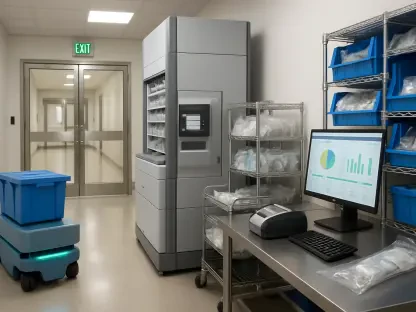The Senate recently passed a Continuing Resolution (CR) to prevent a government shutdown and extend crucial healthcare services. The bill now awaits President Donald Trump’s signature. This vote, conducted on Friday evening, was a pivotal move to maintain federal operations and healthcare provisions, offering funding through September 30, 2025.
Averting a Government Shutdown
Urgent Action Taken
The Senate’s passage of the Continuing Resolution was a necessary and urgent move to prevent a government shutdown, reflecting the critical need to maintain uninterrupted federal operations. With a pressing deadline looming, the Senate responded swiftly to ensure that federal agencies remained operational. The vote result, with 54 senators in favor and 46 against, underscored the immediacy and significance of passing the resolution promptly. This decisive action was crucial in addressing the potential disruptive impact of a shutdown, especially in the context of ongoing federal responsibilities.
The urgency behind the CR was palpable, given that failing to pass the resolution would have led to a government shutdown with far-reaching consequences. Federal agencies, including those integral to public health and safety, would have faced funding interruptions. Such disruptions could have impeded essential services, from healthcare to national security. The Senate’s action, therefore, averted an imminent crisis, facilitating the continued delivery of critical federal functions. The proactive approach demonstrated by the Senate in addressing the potential shutdown through timely legislation played a vital role in ensuring continuity and stability across government operations.
Bipartisan Effort
The passage of the Continuing Resolution by the Senate was also a testament to the bipartisan effort needed to prevent a government shutdown. Despite ideological differences and political tensions, senators from both parties recognized the importance of coming together to ensure continued funding for essential services. The vote showcased a moment of cooperation and pragmatism, highlighting that certain issues transcend partisan divides.
The bipartisan nature of the vote was particularly significant in an era where political polarization often hinders legislative progress. This collective effort underscored the shared responsibility of lawmakers to prioritize the greater good over political disagreements. By setting aside their differences, senators demonstrated a united front in averting a government shutdown, ensuring that key services remained uninterrupted. This display of bipartisanship was crucial in maintaining public trust in the legislative process and affirming the commitment of elected officials to address urgent national issues collaboratively.
Extending Healthcare Services
Key Healthcare Provisions
One of the critical aspects of the Continuing Resolution was its inclusion of significant healthcare provisions slated to expire. The resolution addressed the pressing need to extend various healthcare programs and services that millions of Americans rely on. Key healthcare provisions covered in the CR included extensions for Medicare telehealth services, community health centers, and support measures for hospitals, among others.
These extensions were vital in maintaining continuity of care, particularly for vulnerable populations. For instance, the extension of Medicare telehealth provisions was essential in ensuring that patients continued to have access to remote healthcare services, a crucial resource during the ongoing health challenges. Moreover, community health centers and hospitals, which play a pivotal role in providing care to underserved communities, received extended support. This helped mitigate potential healthcare disruptions and allowed these institutions to continue offering essential services.
Telehealth and Community Health Centers
Specific measures within the Continuing Resolution targeted the expansion of telehealth services and support for community health centers. By addressing the geographic barriers traditionally associated with healthcare access, the CR aimed to remove restrictions and expand the reach of telehealth services. This included provisions to eliminate geographic requirements and expand the originating sites for telehealth consultations. Additionally, the resolution broadened the range of practitioners eligible to provide telehealth services, facilitating greater access to care for patients across different regions.
The CR also extended support for federally qualified health centers (FQHCs) and rural health clinics (RHCs), entities that are crucial in delivering healthcare to underserved and rural communities. These centers provide essential services to millions of Americans, and the extended funding ensured their continued operation. The provisions within the CR aimed to enhance the capacity of these centers to meet the growing healthcare demands, particularly in areas with limited access to medical facilities. By addressing the needs of both telehealth and community health centers, the CR played a significant role in maintaining the integrity of the healthcare system and ensuring that patients had uninterrupted access to necessary services.
Political Dynamics and Debates
Schumer’s Stance
Senate Minority Leader Chuck Schumer’s stance played a pivotal role in the passage of the Continuing Resolution. Initially, there were reservations and opposition from some Senate Democrats regarding the CR’s provisions and overall approach. However, Schumer’s decision to support the resolution marked a critical turning point. His shift in stance was instrumental in securing the necessary votes for the CR’s approval, reflecting a pragmatic approach to the looming deadline and the necessity of averting a government shutdown.
Schumer’s support showcased strategic leadership in navigating the complex legislative landscape. By backing the resolution, he was able to rally additional votes from his colleagues, prioritizing the immediate need to keep the government operational over ideological differences. Schumer’s role in the CR’s passage highlighted the nuanced dynamics within the Senate, where strategic decisions often influence the outcome of critical votes. His pragmatic approach underscored the broader commitment to maintaining essential services and preventing the wide-reaching impacts of a government shutdown.
Potential Conflicts
Despite the ultimate approval of the Continuing Resolution, the legislative process was marked by debates and conflicts among senators. Some Democrats expressed concerns over the bill’s limitations and the lack of comprehensive solutions to ongoing issues. These concerns highlighted the challenges inherent in achieving consensus on complex policy matters. However, the recognition of the necessity to avoid a shutdown prevailed, leading to the resolution’s passage.
The debates underscored the balancing act that lawmakers must navigate, weighing the immediate need for action against the desire for more comprehensive reforms. While the CR provided temporary stability, it also left some unresolved issues that will require future attention. The conflicting viewpoints within the Senate reflected the broader political dynamics where achieving a resolution often involves compromise and prioritization of immediate needs. The passage of the CR, despite the debates, demonstrated the Senate’s ability to navigate conflicting interests and ensure continuity in government operations and essential services.
Looking Ahead
Future Negotiations
The passage of the Continuing Resolution extends federal funding until the end of the current fiscal year, but it also sets the stage for future negotiations. Lawmakers are aware of the impending deadline for the fiscal year 2026, which requires a new agreement by October 1. This looming deadline indicates that while the CR provides temporary respite, it does not eliminate the need for further legislative action. The coming months will involve continued discussions and negotiations to ensure that government operations remain uninterrupted beyond the current fiscal period.
Future negotiations are likely to address not only the extensions provided by the CR but also more comprehensive reforms. The need for a broader healthcare package remains a significant concern, and lawmakers will need to reconcile differences to address issues such as Medicare physician pay cuts and the role of pharmacy benefit managers. The CR’s passage has set a precedent for bipartisanship, but sustained cooperative efforts will be essential in achieving long-term solutions. The legislative focus will need to balance immediate funding needs with strategic reforms to address underlying systemic challenges.
Calls for Healthcare Reforms
Beyond addressing immediate funding needs, there is an ongoing call for substantial healthcare reforms. The Continuing Resolution has highlighted several areas within the healthcare system that require comprehensive policy attention. Among these are issues related to Medicare physician pay cuts and the regulation of pharmacy benefit managers. These aspects are critical in ensuring fair compensation for healthcare providers and addressing drug pricing mechanisms that impact patients.
Lawmakers acknowledge the need for a more substantial healthcare package that goes beyond temporary extensions. The discussions following the CR’s passage are expected to explore long-term solutions to these pressing issues. Healthcare reforms are seen as a necessary step to enhance the efficiency and equity of the healthcare system. Addressing these concerns will require bipartisan efforts, legislative diligence, and possibly more extensive negotiations to ensure that the healthcare system meets the needs of providers and patients alike.
Ensuring Stability in Healthcare
Impact on Providers and Patients
The healthcare provisions within the Continuing Resolution play a crucial role in ensuring stability for healthcare providers and patients. By extending key programs like telehealth services and support for community health centers, the CR addresses immediate needs, particularly amid ongoing health challenges. The continued funding is pivotal in maintaining the public health infrastructure necessary for effective healthcare delivery, ensuring that providers can offer uninterrupted services to patients.
Providers and patients benefit significantly from the stability offered by the CR. For healthcare providers, particularly those in underserved areas, the extended support enables them to continue delivering essential services without interruption. Patients, especially those who rely on community health centers and telehealth services, experience continued access to necessary care. This stability is vital in maintaining public health and addressing healthcare disparities. The CR’s provisions ensure that essential services remain available, supporting the healthcare system’s overall resilience, particularly during periods of heightened demand and ongoing health challenges.
Broad Consensus
Recently, the Senate successfully passed a Continuing Resolution (CR) aimed at averting a government shutdown and ensuring ongoing support for essential healthcare services. This significant vote took place on Friday evening and was a crucial step to keep federal functions running smoothly, directly impacting a wide range of government activities and public services. The Continuing Resolution extends funding for these critical services through September 30, 2025, providing a stable budgetary framework for the next several years.
With the Senate’s approval, the bill now moves to President Donald Trump’s desk for his signature. The passage of this resolution underscores the government’s commitment to avoid disruptions in federal operations and maintain healthcare provisions that are vital for many Americans. Ensuring that key services continue without interruption is of utmost importance, and this action by the Senate highlights the significance of bipartisan cooperation in addressing urgent fiscal obligations.
By securing funding until September 2025, the resolution provides both immediate relief and long-term stability, casting a positive outlook on the federal government’s ability to manage its financial responsibilities while supporting the health and well-being of its citizens. The President’s endorsement is anticipated as the final step to enact this critical measure into law.









